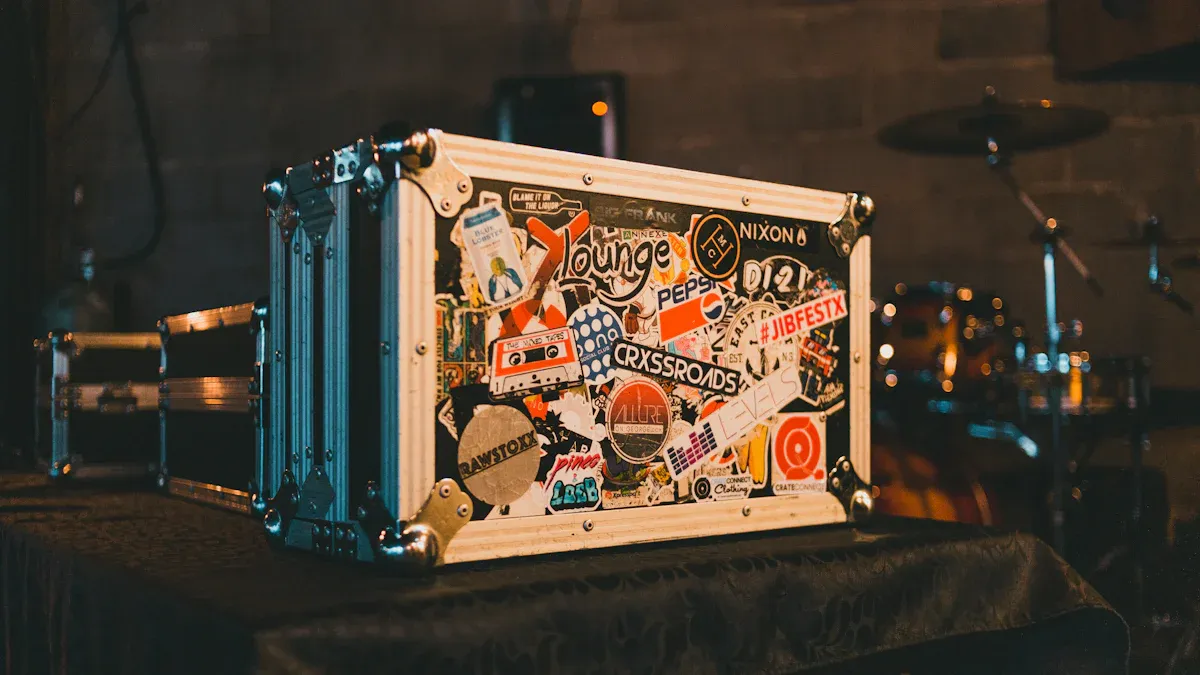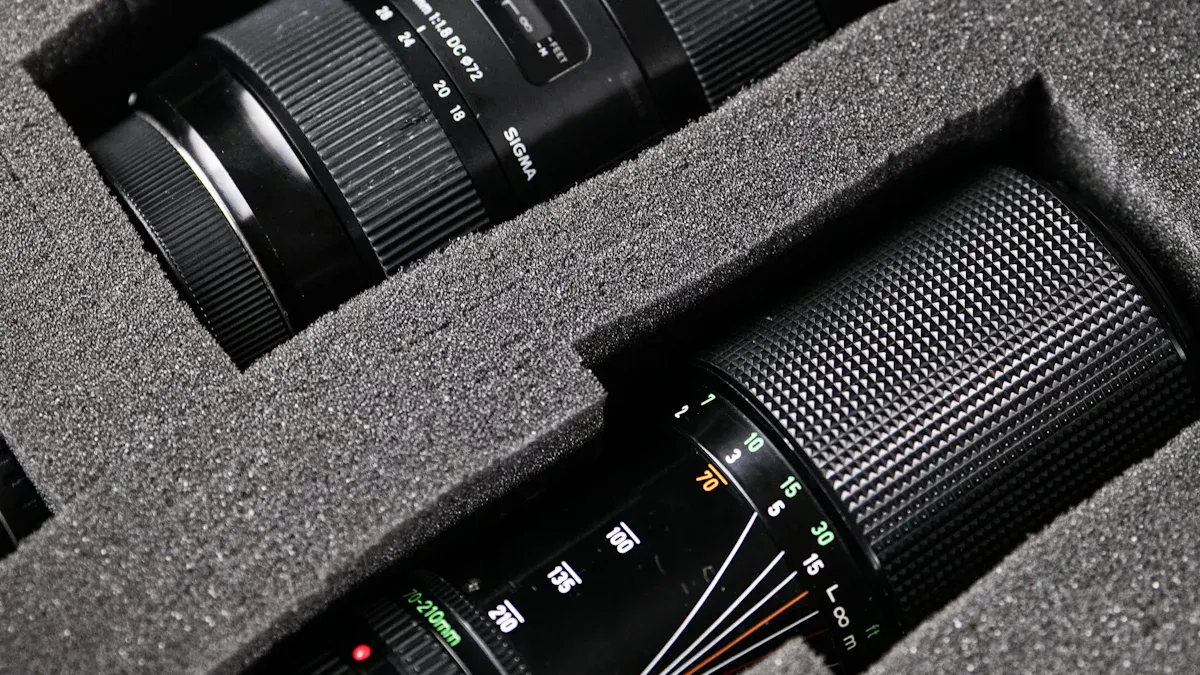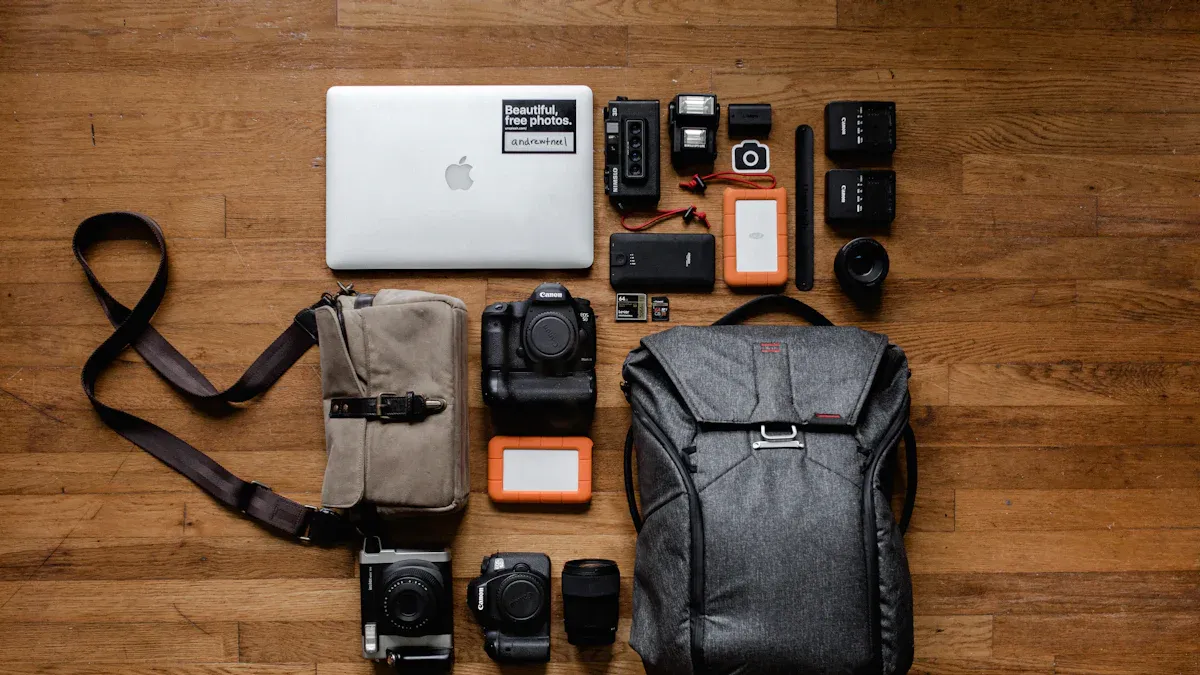
A professional Studio Equipment Trolley Case requires specific features. Robust construction, customizable interior padding, secure locking mechanisms, heavy-duty wheels with a telescopic handle, and superior weather resistance are crucial. These elements safeguard valuable gear. They prevent damage like dented grills, broken headphones, or tangled cables during transport. Such protection ensures equipment longevity and facilitates efficient workflow for any studio professional.
Key Takeaways
- A good studio equipment case needs strong materials and reinforced parts. This protects your gear from damage.
- Custom padding inside the case keeps your equipment safe and organized. It stops items from moving around and breaking.
- Look for cases with strong locks and good seals. This keeps your valuable equipment safe from theft and bad weather like rain or dust.
Robust Construction: The Foundation of a Professional Studio Equipment Trolley Case
Material Strength for Ultimate Protection
The foundation of any reliable Studio Equipment Trolley Case lies in its material strength. High-density polyethylene (HDPE) offers superior impact resistance. This material remains lightweight, yet it is tough enough for demanding applications like military and aerospace cases. Manufacturers also use polypropylene, an injection-molded high-strength polymer resin. These materials make cases watertight, dust-proof, and highly impact resistant. They provide ultimate protection for sensitive studio gear.
Reinforced Corners and Edges for Durability
Reinforced corners and edges provide crucial durability. These features absorb shock from accidental drops and bumps. They prevent structural damage to the case itself. This design ensures the case maintains its integrity even under harsh conditions. Strong corners and edges significantly extend the lifespan of the equipment case.
Overall Build Quality and Longevity
Overall build quality determines a case’s longevity. A well-constructed case withstands rigorous daily use and frequent transport. It protects valuable equipment over many years. Superior build quality means components fit precisely and materials endure stress. This investment safeguards gear and ensures reliable performance for studio professionals.
Customizable Interior Padding: Tailored Gear Security in Your Studio Equipment Trolley Case

Customizable interior padding offers tailored security for valuable studio equipment. This feature ensures each item fits snugly, preventing damage during transit. Professionals rely on precise organization and protection for their sensitive tools.
Benefits of Pick-and-Pluck Foam vs. Padded Dividers
Two primary options exist for interior customization: pick-and-pluck foam and padded dividers. Pick-and-pluck foam provides a highly precise fit. Users remove small foam cubes to create exact cutouts for specific gear shapes. This method offers maximum shock absorption for individual items. Padded dividers, conversely, offer greater reconfigurability. Users adjust these Velcro-attached partitions to accommodate different equipment layouts. This flexibility benefits professionals who frequently change their gear setup.
Preventing Movement and Absorbing Shock
Effective padding prevents equipment movement and absorbs shock. When designing custom foam, professionals consider the weight and fragility of items. Heavier equipment requires denser foam for adequate support. This prevents the gear from ‘bottoming out,’ where the foam fully compresses. Fragile equipment benefits from softer foam, which provides effective cushioning without transmitting shock. For instance, Polyurethane (PU) foam often has a density around 1.6 lbs/ft³. Cross-Linked Polyethylene (XLPE) foam ranges from 2 lb/ft³ up to 15 lb/ft³. The correct foam density protects equipment without adding unnecessary bulk.
Accommodating Diverse Studio Equipment
Customizable interiors accommodate diverse studio equipment. Professionals transport various items, including cameras, lenses, microphones, and cables. Tailored padding ensures each piece, regardless of its size or shape, receives optimal protection. This adaptability makes a Studio Equipment Trolley Case an indispensable tool for any professional.
Secure Locking Mechanisms: Protecting Your Studio Equipment Trolley Case from Theft
Types of Reliable Locking Systems
Secure locking mechanisms are essential for protecting valuable studio equipment. Many cases feature robust latches, often made from stainless steel or reinforced ABS plastic. Some models incorporate TSA-approved combination locks directly into the latches. This allows airport security to inspect contents without damaging the lock. Other cases offer padlock-ready hasps. Users can then add their preferred high-security padlock. High-security swing door locks are crucial for protecting valuable cargo in other industries, acting as a strong deterrent against theft. Similarly, a Studio Equipment Trolley Case benefits from such robust security. Retailers frequently use locking display cases to secure high-value, easily portable items. This practice underscores the importance of secure storage for sensitive gear.
Importance of Durable Closures
Durable closures are vital for preventing unauthorized access and resisting tampering. Weak latches or flimsy locks offer little protection. They can easily break or bend, compromising the case’s security. Strong, well-engineered closures withstand forced entry attempts. They visibly signal that the contents are secured, making forced entry difficult and time-consuming. This often discourages criminals. Quality closures also ensure the case remains tightly sealed, protecting against environmental factors like dust and moisture.
Peace of Mind with Secure Mechanisms
Secure locking mechanisms provide studio professionals with invaluable peace of mind. Knowing that expensive cameras, lenses, and audio equipment are safe from theft allows focus on creative work. It eliminates worry during transport or when leaving the case unattended for short periods. This security ensures equipment remains ready for use, protecting significant investments.
Heavy-Duty Mobility: Wheels and Handles for Your Studio Equipment Trolley Case
Efficient mobility is paramount for any professional Studio Equipment Trolley Case. Quality wheels and ergonomic handles ensure easy transport of valuable gear. They reduce physical strain and enhance workflow.
Characteristics of Quality Wheels
Quality wheels are fundamental for smooth and reliable transport. Various materials contribute to their longevity and performance.
- Reinforced corners increase durability. They provide extra strength to the wheel assembly.
- Specialized hardware, such as robust casters, contributes to the overall durability of the case.
| Material | Key Features Contributing to Longevity |
|---|---|
| Metal | High load capacity, high heat tolerance |
| Rubber | Long-wearing, soft tread with hard backing |
| Polyurethane | Long-wearing, high load capacity, quiet operation |
| Nylon/Plastic | Easy rolling, chemical-resistant, high load capacity |
| Pneumatic/Solid/Semi | Accommodates rough surfaces, larger diameters for easier rolling |
Polyurethane wheels offer smooth and quiet operation. They provide high load capacity and stability. Nylon wheels are known for exceptional load capacity. They suit heavy-duty applications. They resist chemicals, oils, and solvents. Steel and iron are used for frame construction. They withstand high temperatures. Plastic wheels are economical and lightweight. They resist corrosion.
These wheels also handle significant weight.
| Caster Type | Load Capacity (lbs.) |
|---|---|
| Heavy Duty | 5,000 – 14,999 |
| Extra Heavy Duty | 15,000 – 34,999 |
| Super Heavy Duty | 35,000 – 100,000+ |
Ergonomics and Durability of the Telescopic Handle
A well-designed telescopic handle significantly reduces user strain.
- Adjustable length allows users to avoid unnecessary bending. This accommodates various heights and promotes straight posture.
- Handles reduce strain and fatigue. They specifically alleviate pressure on hands, wrists, and the lower back.
- Improved grip and control are crucial. Features like a non-slip grip and balanced weight offer better handling, even when wet.
Durable handles withstand frequent extension and retraction. They maintain structural integrity over time.
Maneuverability Across Various Terrains
High-quality wheels and handles ensure excellent maneuverability. They allow easy navigation across diverse terrains. Smooth floors, uneven pavements, and even rough outdoor surfaces become manageable. Larger wheel diameters and pneumatic options are ideal for outdoor applications. They provide easier rolling and absorb shocks from bumps. This ensures equipment remains stable during transit.
Weather Resistance: Shielding Your Studio Equipment Trolley Case from the Elements
IP Ratings and Their Significance
Weather resistance is crucial for protecting sensitive studio equipment. Ingress Protection (IP) ratings quantify a case’s ability to resist dust and water. An IP rating consists of two digits. The first digit indicates protection against solid particles, like dust, on a scale of 0 to 6. A ’6′ signifies complete dust-tightness. The second digit represents protection against liquids, ranging from 0 to 8. An ’8′ means the case withstands continuous immersion in water. Professionals should seek cases with high IP ratings. These ratings ensure superior protection for valuable electronics in various environments.
Importance of Airtight Seals and O-Rings
Airtight seals and O-rings form a critical barrier against environmental threats. These components prevent moisture, dust, and other contaminants from entering the case. High-quality O-rings maintain their integrity across a wide range of temperatures and conditions.
| Material | Temperature Range | Key Resistances | Applications |
|---|---|---|---|
| Ethylene-Propylene (EPDM) | -55°F to 275°F | Chemical, high heat, steam, glycol-based fluids | Hot/cold water systems, brake systems |
| Chloroprene (Neoprene) | -40°F to 250°F | Ozone, heat, abrasion | Refrigeration systems, silicon oils |
| Silicone (VMQ) | -85°F to 400°F | Temperature, UV, ozone, fungal growth | Food, beverage, medical industry |
These materials ensure the seal remains effective. They prevent water ingress during rain or accidental spills. They also stop fine dust particles from reaching delicate components.
Critical Environmental Protection for Electronics
Electronic equipment requires stringent environmental protection. Moisture causes short circuits and corrosion. Dust abrades moving parts and interferes with electrical contacts. Extreme temperatures also degrade performance and shorten lifespan. A weather-resistant case shields electronics from these damaging elements. It maintains a stable internal environment. This protection ensures equipment functions reliably and lasts longer. It safeguards significant investments in studio technology.
Internal Organization: Maximizing Space in Your Studio Equipment Trolley Case

Effective internal organization transforms a simple container into a highly functional tool. It ensures professionals can transport a large volume of gear efficiently and safely. A well-designed interior maximizes space and protects every item.
Efficient Layout for Large Volumes of Gear
An efficient layout is crucial for managing extensive equipment collections. Professionals often utilize modular systems or adjustable dividers. These allow for custom configurations that fit various items snugly. Strategic placement of larger items creates a stable base. Smaller accessories then fill the remaining spaces. This approach prevents wasted space and keeps gear secure during transit.
Dedicated Compartments for Delicate Items
Dedicated compartments are essential for safeguarding delicate equipment. Professionals should never rely on "fragile" stickers on checked luggage; these rarely change handling methods. Instead, they should use hard-shell suitcases with soft linings or built-in padding. Specialized packing cubes, padded pouches, and anti-shock sleeves offer smarter organization for fragile electronics or glassware. For instance, wrap jewelry in soft cloth pouches or thread chains through straws to prevent tangling. Wrap glassware in thick scarves or bubble wrap, placing it among soft clothing layers away from case edges. For electronics, use padded sleeves and position them centrally, surrounded by clothes. Layer microfiber cloth between devices in hard-shell cases. Small zipped pouches keep chargers and accessories organized. Professionals can also repurpose clean egg cartons for small glass goods or use contact paper to wrap breakables, absorbing shocks and preventing dust.
Balancing Storage and Accessibility
Balancing storage and accessibility ensures both protection and efficiency. An ideal internal setup protects all gear while allowing quick access to frequently used items. Professionals often place essential tools in easily reachable sections. Less critical or rarely used items reside in deeper, more secure compartments. This thoughtful arrangement minimizes setup time and streamlines workflow on location.
Design Considerations: Portability and Practicality for Your Studio Equipment Trolley Case
Studio professionals require equipment cases that offer both portability and practicality. These design elements ensure efficient transport and storage of valuable gear.
Balancing Mobility and Payload Capacity
Balancing mobility and payload capacity is crucial for any professional. A case must protect heavy equipment without becoming too cumbersome to move. Manufacturers use advanced materials to achieve this balance. Plastic cases, for example, are lightweight and corrosion-resistant. They come in various types, including ABS, polycarbonate, polypropylene, and Fiber Reinforced Plastic (FRP). These plastics offer impact resistance, flexibility, and ease of shaping. Aluminum cases provide a premium appearance and an excellent strength-to-weight ratio. They are often used for electronics, optics, and audiovisual equipment, offering both physical protection and EMI/RFI shielding. Aluminum is also rust-resistant and can be anodized for enhanced durability.
Lightweight Options for Travel
Lightweight options significantly improve travel convenience. Cases constructed from advanced polymers or aluminum alloys reduce the overall weight. This makes them easier to carry or roll through airports, studios, or remote locations. Reduced weight also helps avoid excess baggage fees, a common concern for traveling professionals.
Stackable Designs for Storage and Transport
Stackable designs offer significant advantages for storage and transport. These cases maximize warehouse capacity by utilizing vertical space. They allow products to be stored several units high, which reduces the need for multiple aisles. This optimizes available warehouse space. Stackable racks also improve order fulfillment. They act as pallets, enabling easy movement of inventory without constant loading or unloading. They provide organized and accessible storage, making it easier for employees to locate and retrieve items. This leads to faster order processing. Furthermore, stack racks prevent product damage. They offer multiple compartments, allowing for several shipments to be kept load-on-load. This reduces losses and costs associated with damaged goods. Stackable racks are portable and do not require ground installation. This offers flexibility for warehouse reconfiguration and seasonal storage. Forklifts and pallet jacks can easily move them, making them suitable for dynamic warehouse environments.
Ventilation and Overheating Prevention in Rack Studio Equipment Trolley Cases
Importance of Airflow for Rack-Mounted Gear
Proper airflow is crucial for rack-mounted studio gear. Equipment crowding in incorrectly sized A/V racks increases the risk of damage and overheating. Racks that do not manage heat generated by electronics can result in equipment failure and costly replacements. A lack of proper ventilation within the rack or the room causes heat buildup. This leads to overheating and potential damage to electronic equipment.
- Overheating can cause permanent damage to components. This includes melting, warping, cracking, or burning. It can also lead to fire hazards and safety risks.
- Heat accelerates wear and tear on components. This shortens the device’s lifespan and increases susceptibility to failures.
- Thermal throttling occurs when a device reduces its speed or power to prevent overheating. This negatively impacts audio and video output quality, causing glitches and errors.
- A dirty and disorganized AV rack leads to major performance problems and reduces equipment lifespan.
- Dust accumulation blocks ventilation. This forces fans to work harder and increases noise.
- In extreme cases, dust buildup can become a fire risk or cause electrical breakdowns. This leads to expensive repairs or irreversible damage.
Preventing Equipment Overheating
Preventing equipment overheating is essential for maintaining gear integrity and performance. Effective airflow management directly addresses the issues of heat buildup. It ensures sensitive electronics operate within safe temperature ranges. This proactive approach extends the lifespan of valuable studio equipment. It also prevents costly repairs or replacements. Proper ventilation maintains consistent performance, avoiding thermal throttling and output quality degradation.
Design Features for Optimal Ventilation
Rack cases incorporate specific design features to promote optimal ventilation. These features ensure efficient cooling for all mounted equipment.
- Perforated Doors: These allow cold air to reach servers directly. Solid doors, in contrast, direct airflow differently.
- Blanking Panels: These cover unused rack spaces. They prevent cold air from bypassing equipment and mixing with hot air. This improves energy use and reduces hotspots.
- Vents/Louvers: These utilize natural convection. Warm air rises and cool air replaces it. Louvers at the top allow hot air escape, and bottom louvers facilitate cool air intake.
- Fans: These provide forced ventilation. They increase airflow and cooling rates compared to natural convection.
- Heat Sinks: These are designed for components that generate significant heat. They improve thermal management.
Prioritizing these critical features ensures a Studio Equipment Trolley Case provides optimal protection, convenience, and longevity. Investing in a high-quality case with these characteristics is a strategic decision. It safeguards valuable gear and enhances professional workflow.
A well-chosen case becomes an indispensable tool for any serious studio professional.
FAQ
What materials offer the best protection for a studio equipment trolley case?
High-density polyethylene (HDPE) and polypropylene provide superior impact resistance. Aluminum offers an excellent strength-to-weight ratio and EMI/RFI shielding. These materials ensure robust protection for valuable gear.
How do IP ratings protect studio equipment?
IP ratings quantify a case’s resistance to dust and water. A high IP rating ensures the case shields sensitive electronics from environmental contaminants. This prevents damage and extends equipment lifespan.
Why is internal organization crucial for a trolley case?
Effective internal organization maximizes space and protects every item. It prevents gear movement and damage during transit. Dedicated compartments safeguard delicate equipment, ensuring accessibility and efficiency for professionals.
Post time: Nov-14-2025




